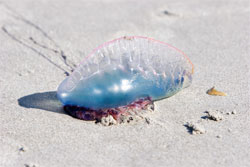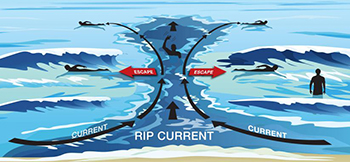Lightning

You’re lying on the beach. It’s a hot and hazy summer day. Then suddenly you hear thunder in the distance. Get moving! The lightning that caused that thunder can kill.
Lightning occurs with ALL thunderstorms. In Florida, thunderstorms are most likely to happen in the spring and summer months and during the afternoon but they can occur year round at all hours. Strong winds are also a danger associated with some storms.
Lightning in marine areas is particularly dangerous. Boaters, fishermen, and beachgoers, as well as people on piers, should be alert. Lightning can occur when the sky is blue and there is no rain in sight. Frequently, strikes occur just prior to the onset of a thunderstorm.
Lifeguards watch for signs of approaching storms and are alerted of the latest radar forecasts. Lifeguards will clear patrons off the beach and out of the water when a storm is 6 miles away. If the storm is approaching quickly or if the beach is crowded, beachgoers will be alerted sooner.
Palm Beach County Ocean Rescue offers the following beach tips to avoid being hit by lightning when a storm approaches:
Stay out of the water
- Leave beaches, piers, and boardwalks; seek shelter as soon as possible.
- Move to a sturdy building. Once inside, stay away from any wiring or plumbing.
- A hard top car provides protection but do not touch any metal in the car.
- If no shelter is available, seek the lowest spot you can find. Don’t be the highest object on the horizon, and avoid open spaces. Don’t sit under beach umbrellas or on aluminum beach chairs.
- Do not take a shower.
Portuguese Man o' War

On the beach it’s not unusual to see an object that looks like a harmless blue plastic bag. The curious beachcomber who picks it up or pops it, could be in for a painful shock. That tinted pink, blue, or purple gas filled float, similar to a small oblong balloon, is a Portuguese man o’ war, a siphonophore, an animal made up of a colony of organisms working together. The Portuguese man o’ war comprises four separate polyps. It gets its name from the uppermost polyp, a gas-filled bladder, or pneumatophore, which sits above the water and somewhat resembles an old warship at full sail. Portuguese man o’ war are also known as bluebottles for the purple-blue color of their pneumatophores. The tentacles are the Portuguese man o’ war's second organism. These long, thin tendrils can extend 165 feet in length below the surface, although 30 feet is more the average. They are covered in venom-filled nematocysts used to paralyze and kill fish and other small creatures. For humans, a Portuguese man o’ war sting is excruciatingly painful, but rarely deadly. Even dead Portuguese man o’ wars washed up on shore can deliver a sting. Muscles in the tentacles draw prey up to a polyp containing the gastrozooids or digestive organisms. A fourth polyp contains the reproductive organisms. (Source: National Geographic)
They are predominately present during the months of November through April. Strong easterly winds carry them to shore and the shoreline.
Portuguese man o’ war are infamous for their very painful powerful stings, leaving whip-like, red welts on the skin and normally lasting 2-3 days after the initial sting. The pain can last up to an hour and usually stays in the area where the victim is stung. Occasionally the pain will travel to other parts of the body. A sting may lead to an allergic reaction. There can be serious side effects, including tightness in the chest, respiratory difficulty, stomach cramps, nausea, vomiting, and shock, requiring immediate medical attention. Young children, the elderly, and people who are prone to allergic reactions from bee stings and other insect bites are more susceptible to the serious symptoms.
Anyone who suffers a Portuguese man o’ war sting should seek the assistance of a lifeguard, who will treat the victim with plain distilled vinegar. If a lifeguard is unavailable, any tentacles visible on the skin of the victim should be carefully pulled off immediately using a towel, stick or anything handy, taking care not to touch them to avoid a secondary sting. Flush the affected area with salt water to remove any adhering tentacles. Do NOT rub the affected area. Hot packs or hot showers also give relief. For persistent itching or skin rash, see a local pharmacist for hydrocortisone ointment or Benadryl.
When the Portuguese man o’ war is present, the purple flag will be flown on lifeguard towers.
Rip Currents - Break the Grip of the Rip!

Watch: Rip Current Safety Animation| Beach Safety - Rip Currents
Rip currents are powerful currents of water moving away from shore. They can sweep even the strongest swimmer out to sea.  Rip Current Warning Sign
Rip Current Warning Sign
If caught in a rip current:
- Relax, rip currents don't pull you under
- Don't swim against the current
- Swim out of the current, then to shore
- If you can't escape, float or tread water
- If you need help, yell or wave for assistance
Sea Pests
Jellyfish
Jellyfish often sneak up on their victims. Bathers are playing in the surf one minute and feel the sting of the jellyfish the next. Most jellyfish stings are completely harmless and do not pose a serious risk. They are usually more prominent in the warmer summer months. If you have been stung, go to the nearest lifeguard and (s)he will spray the area with plain distilled vinegar. Usually the pain and/or itch will be relieved in 15 minutes. If the pain persists a hot shower will help.
Sea Bather’s Eruption
Sea Bather’s Eruption, more commonly known as sea lice, is a condition that has been documented along Florida’s southern Atlantic coast since the 1900’s. At times the sea lice are absent for twenty years, but reappear when the ocean currents shift. The problem is diminishing but still present.
Sea Lice is caused by miniature jellyfish larvae trapped under bathing suits, t-shirts, and even hair when in the water. If pressure occurs from exercising, surf boards, lying on the beach, etc., stinging cells are released causing itching, irritation, and welts. Some people do experience a “prickling” sensation while in the water, though itching usually starts several hours after being in the water and lasts 2-4 days, but can last as long as two weeks! Some people may have more severe reactions such as: headache, fever, and nausea.
At Palm Beach County beaches, sea lice signs will be posted when they are present. Swimmers should immediately shower after swimming, making sure your bathing suit is removed before showering. Bathing suits should be thoroughly washed with detergent and heat dried.
Use any treatment that helps relieve itching. Benadryl and cortisone cream may be helpful. For severe reactions call your physician immediately.
Swimmer’s itch
Swimmer’s itch appears as a mild rash caused by an allergic reaction to specific parasites found in certain birds and mammals. These microscopic parasites are released from infected snails. Rather than finding a host bird or mammal, the parasite instead burrows into the nearby swimmer’s skin, causing a rash. This problem occurs most frequently during the summer.
Sharks
Questions about sharks are among the questions most frequently asked to lifeguards. Sharks are a potential danger that must be acknowledged, but things should be kept in perspective. Many more people are injured and killed while driving to and from the beach than bitten by sharks and shark bites are less common than such beach related injuries as spinal damage, dehydration, jellyfish stings, sunburn, and lightning. Ocean lifeguards are trained to look for dangerous marine life. When they spot a shark in close proximity, all bathers will be called out of the water, and the double red flags will be flying from the lifeguard towers.
Dr. George Burgess, Director of the International Shark Attack Files at the University of Florida, Florida Museum of Natural History says the chances of interacting with a shark can be reduced if one heeds the following advice:
- Always stay in groups since sharks are more likely to attack a solitary swimmer.
- Do not wander too far from shore where you will be isolated and far away from assistance.
- Avoid the water during darkness or twilight hours when sharks are most active and have a competitive sensory advantage.
- Do not enter the water if bleeding from an open wound or if menstruating – a shark’s olfactory ability is acute.
- Do not wear shiny jewelry because it reflects light and resembles the sheen of fish scales.
- Avoid waters with effluents or sewage and those being used by sport or commercial fishermen, especially if there are signs of bait fish or feeding activity. Diving seabirds are good indicators of the presence of fish.
- Porpoise sightings do not indicate the absence of sharks – both often eat the same food items.
- Use extra caution when waters are murky. And remember that sharks may be attracted by contrasting colors such as bright swim suits or uneven tans.
- Refrain from excessive splashing, and do not allow pets in the water because of their erratic movements.
- Exercise caution when occupying areas between sandbars or near steep drop offs as these are favorite hangouts for sharks.
- Do not enter the water if sharks are known to be present and evacuate the water if sharks are sighted. And, of course, do not harass a shark if you see one.
Sun Safety
Everyone loves to come to Florida, go to the beach, and get a tan. But, unfortunately there is no way to tan safely. The sun’s reflective powers on the sand and the water are great and may cause severe damage to your skin if you don’t take a few precautions.
Everyone needs to wear sunscreen daily, regardless of their skin tone. Even on cloudy days you can get sunburn. Clouds don’t filter out Ultra Violet (UV) rays and can give a false sense of protection. You may also be unaware that you’re developing sunburn on cooler or windy days because the temperature or breeze keeps your skin feeling cool on the surface.
The sun’s rays are the strongest between the hours of 10:00 am and 4:00 pm. The Palm Beach County Ocean Rescue staff recommends that you wear a wide brimmed hat, sunglasses, and protective clothing when not swimming. Always use a sunscreen with a sun protection factor (SPF) of 15 or higher year round for all skin types. You should also drink lots of water.
For maximum effectiveness, sunscreen should be applied 30 minutes before you go outside. This allows the sunscreen to penetrate the skin. Reapply sunscreen every 2-3 hours and apply liberally. Water resistant products can be rubbed off after towel drying or lose their effectiveness after prolonged swimming or heavy perspiration. For continued protection reapply sunscreen, regardless of the label, when you come out of the water.
Some medications increase the skin’s sensitivity to UV rays. Ask your doctor or pharmacist if any of your prescriptions and over-the-counter medications can increase sun sensitivity.
Sunburn often doesn’t appear until later in the day.
- If you have sunburn: Apply wet cool compresses to the skin to alleviate pain and heat, or take a cool shower or bath
- Apply pure aloe vera gels to provide comfort and help skin heal faster
- Drink fluids
- Seek medical help if the burn is accompanied by headache, faintness, chills, fever, or blisters form over a large area
- Stay out of the sun until the sunburn is healed